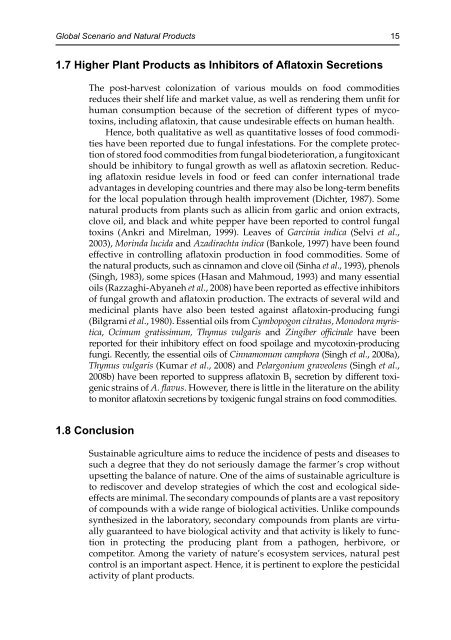natural-products-in-plant-pest-management
natural-products-in-plant-pest-management
natural-products-in-plant-pest-management
You also want an ePaper? Increase the reach of your titles
YUMPU automatically turns print PDFs into web optimized ePapers that Google loves.
Global Scenario and Natural Products 151.7 Higher Plant Products as Inhibitors of Aflatox<strong>in</strong> SecretionsThe post-harvest colonization of various moulds on food commoditiesreduces their shelf life and market value, as well as render<strong>in</strong>g them unfit forhuman consumption because of the secretion of different types of mycotox<strong>in</strong>s,<strong>in</strong>clud<strong>in</strong>g aflatox<strong>in</strong>, that cause undesirable effects on human health.Hence, both qualitative as well as quantitative losses of food commoditieshave been reported due to fungal <strong>in</strong>festations. For the complete protectionof stored food commodities from fungal biodeterioration, a fungitoxicantshould be <strong>in</strong>hibitory to fungal growth as well as aflatox<strong>in</strong> secretion. Reduc<strong>in</strong>gaflatox<strong>in</strong> residue levels <strong>in</strong> food or feed can confer <strong>in</strong>ternational tradeadvantages <strong>in</strong> develop<strong>in</strong>g countries and there may also be long-term benefitsfor the local population through health improvement (Dichter, 1987). Some<strong>natural</strong> <strong>products</strong> from <strong>plant</strong>s such as allic<strong>in</strong> from garlic and onion extracts,clove oil, and black and white pepper have been reported to control fungaltox<strong>in</strong>s (Ankri and Mirelman, 1999). Leaves of Garc<strong>in</strong>ia <strong>in</strong>dica (Selvi et al.,2003), Mor<strong>in</strong>da lucida and Azadirachta <strong>in</strong>dica (Bankole, 1997) have been foundeffective <strong>in</strong> controll<strong>in</strong>g aflatox<strong>in</strong> production <strong>in</strong> food commodities. Some ofthe <strong>natural</strong> <strong>products</strong>, such as c<strong>in</strong>namon and clove oil (S<strong>in</strong>ha et al., 1993), phenols(S<strong>in</strong>gh, 1983), some spices (Hasan and Mahmoud, 1993) and many essentialoils (Razzaghi-Abyaneh et al., 2008) have been reported as effective <strong>in</strong>hibitorsof fungal growth and aflatox<strong>in</strong> production. The extracts of several wild andmedic<strong>in</strong>al <strong>plant</strong>s have also been tested aga<strong>in</strong>st aflatox<strong>in</strong>-produc<strong>in</strong>g fungi(Bilgrami et al., 1980). Essential oils from Cymbopogon citratus, Monodora myristica,Ocimum gratissimum, Thymus vulgaris and Z<strong>in</strong>giber offic<strong>in</strong>ale have beenreported for their <strong>in</strong>hibitory effect on food spoilage and mycotox<strong>in</strong>-produc<strong>in</strong>gfungi. Recently, the essential oils of C<strong>in</strong>namomum camphora (S<strong>in</strong>gh et al., 2008a),Thymus vulgaris (Kumar et al., 2008) and Pelargonium graveolens (S<strong>in</strong>gh et al.,2008b) have been reported to suppress aflatox<strong>in</strong> B 1secretion by different toxigenicstra<strong>in</strong>s of A. flavus. However, there is little <strong>in</strong> the literature on the abilityto monitor aflatox<strong>in</strong> secretions by toxigenic fungal stra<strong>in</strong>s on food commodities.1.8 ConclusionSusta<strong>in</strong>able agriculture aims to reduce the <strong>in</strong>cidence of <strong>pest</strong>s and diseases tosuch a degree that they do not seriously damage the farmer’s crop withoutupsett<strong>in</strong>g the balance of nature. One of the aims of susta<strong>in</strong>able agriculture isto rediscover and develop strategies of which the cost and ecological sideeffectsare m<strong>in</strong>imal. The secondary compounds of <strong>plant</strong>s are a vast repositoryof compounds with a wide range of biological activities. Unlike compoundssynthesized <strong>in</strong> the laboratory, secondary compounds from <strong>plant</strong>s are virtuallyguaranteed to have biological activity and that activity is likely to function<strong>in</strong> protect<strong>in</strong>g the produc<strong>in</strong>g <strong>plant</strong> from a pathogen, herbivore, orcompetitor. Among the variety of nature’s ecosystem services, <strong>natural</strong> <strong>pest</strong>control is an important aspect. Hence, it is pert<strong>in</strong>ent to explore the <strong>pest</strong>icidalactivity of <strong>plant</strong> <strong>products</strong>.


